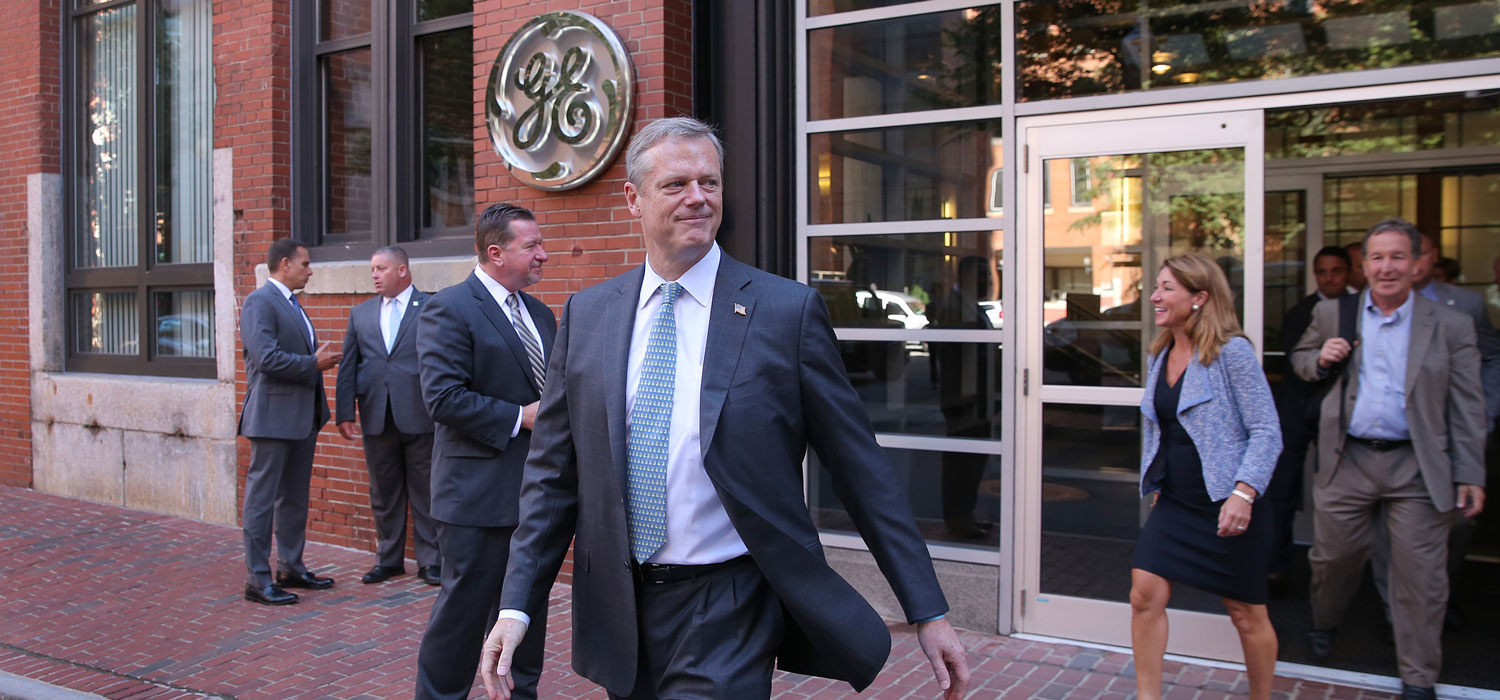
<p>Gov. Charles Baker leaves the entrance to GE. General Electric has opened its new headquarters in Fort Point on Farnsworth Street in Boston, Aug. 22, 2016. Photo by David L. Ryan/The Boston Globe via Getty Images.</p>
General Electric decided to relocate its headquarters from Fairfield, Connecticut, to Boston, Massachusetts, last year. To convince GE to make the move, state government agencies and the city of Boston collaborated to offer the company millions of dollars in incentives, including special access to Logan International Airport and assistance for GE workers relocating to Boston.
Although tax incentives often grab headlines, such as in Carrier’s deal with Indiana, states often woo firms with mega-deals that include a combination of inducements.

But do these deals matter? It’s difficult to tell how much of the incentive is an extra reward for GE (that is, GE was planning to move anyway) and how much was necessary for it to relocate. Whether GE needed a publicly financed incentive to move to a high-technology and highly educated hub like Boston is debatable. And that’s why it’s critical for policymakers to study economic development, coordinate their efforts across departments and regions, and evaluate trade-offs between different types of investment.
As Norton Francis and I outline in our new report, states use three strategies to attract firms and encourage economic development, each of which came into play in the GE deal:
- Investments in business. Boston gave GE $25 million in property tax incentives, but the investment didn’t stop there. The city and state also provided “concierge” services to assist GE in moving its headquarters and people. This included promises of attention from key staff in the governor’s and mayor’s office, identification of temporary office space, and establishment of a mobile office for GE employees relocating to Massachusetts. General Electric also received access to the airport and parking for aircraft, preferences few other businesses in the state enjoy.
- Investments in the workforce. Massachusetts offers workforce programs that any firm can use, but the state agreed to provide GE $1 million in customized employee training and, as part of the concierge services, to help identify other appropriate state programs. For example, GE has already begun posting jobs on Massachusetts JobQuest, an online job board hosted by the Executive Office of Labor and Workforce Development.
- Investments in community. Infrastructure investments were the bulk of the incentive package, accounting for $250 million. These included targeted improvement projects at the selected site location ($120 million) and a bridge renovation and transit upgrades that will benefit the entire Boston community ($125 million).
So what part of this mega-deal convinced GE to move?
Tax incentives are alluring to policymakers because they usually have a higher short-term political return than long-term policies like investments in education or infrastructure. These latter investments and the Boston labor force, however, are likely part of what made Boston an attractive option for GE.
Research suggests that real economic activity is fairly unresponsive to changes in taxes and that firms care more about workforce development and infrastructure. In 2016, firms ranked highway access, availability of skilled labor, and cost of labor as the most important business location factors, with tax incentives and rates ranking fifth or lower.
To untangle this web and encourage accountability, states should do the following during and after every deal:
- Evaluate which provisions influenced the location decision. If the provisions for smoothing out regulations, permitting, and employee relocation were most important, the state and city should revisit service administration and assess how to improve the process for other businesses and new residents. This may require interviewing decisionmakers within GE and other businesses to understand which parts of the deal were most effective.
- Identify the incentives that benefit the broader community in addition to the targeted firm. Infrastructure and community investments, for example, can benefit both. Understanding whether and how much broader environmental amenities influenced decisionmaking is important. This can allow policymakers to weigh the costs of these incentives against the benefits enjoyed not only by the firm but by the entire community.
- Encourage continued transparency. We know a lot about the GE deal because of its commendable transparency. This transparency could set the bar for other companies that want special airport access and specific improvements to public space.
Evaluating mega-deals is a challenge because each location, firm, and negotiation is unique, making it difficult to compare outcomes in one state with outcomes in another. During negotiations, governments often lack complete information about competing deals from other states and are unaware of how much existing amenities, infrastructure, or workforce are driving the firm’s relocation decision.
Although evaluating programs is a challenge, the only way states can navigate these tricky negotiations is to gather as much information as possible. To help, we’ve pulled together some tools to help states understand the trade-offs associated with economic development initiatives.
Let’s build a future where everyone, everywhere has the opportunity and power to thrive
Urban is more determined than ever to partner with changemakers to unlock opportunities that give people across the country a fair shot at reaching their fullest potential. Invest in Urban to power this type of work.